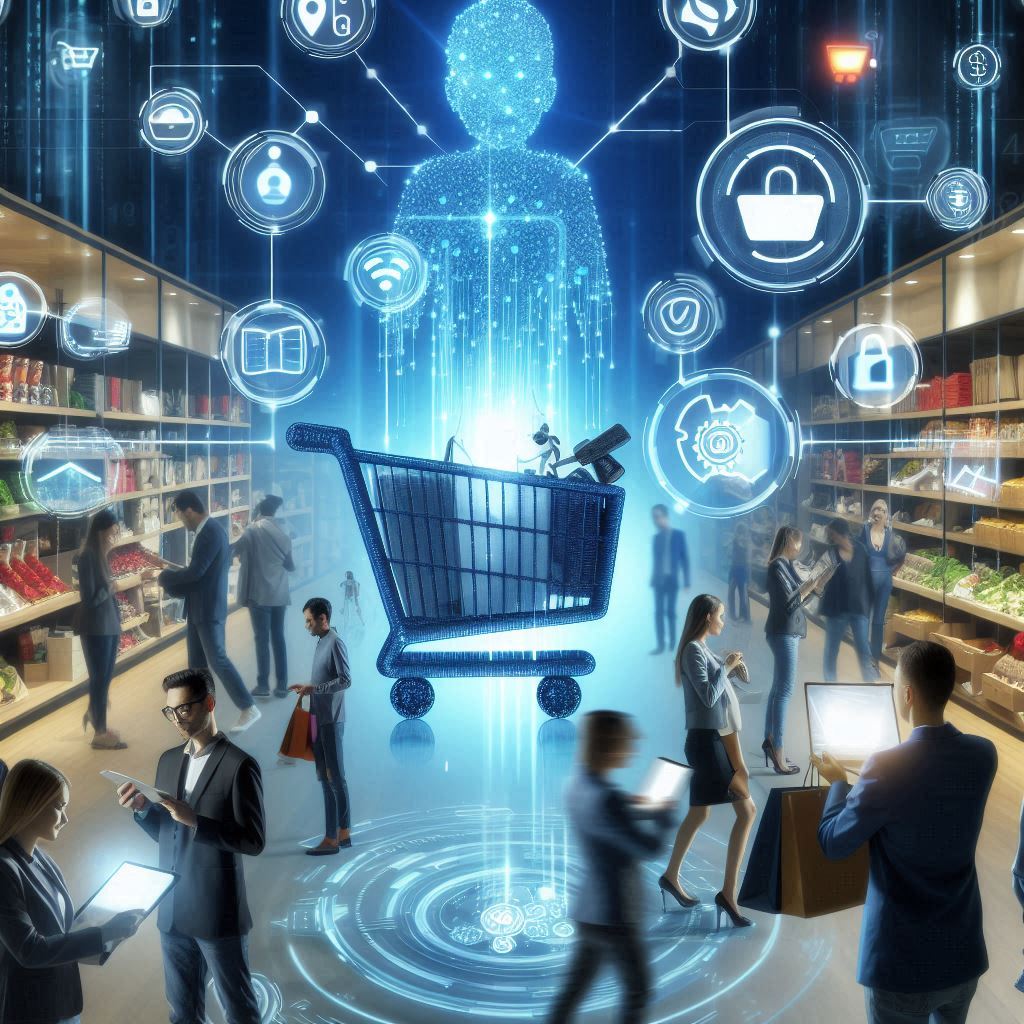Abstract :
AI in Retail: Enhancing Customer Experience and Optimizing Operations
Introduction
The retail industry is experiencing a transformative shift, driven by the integration of Artificial Intelligence (AI) technologies. From personalized shopping experiences to efficient inventory management, AI is revolutionizing how retailers operate and engage with customers. This detailed blog post explores how AI is enhancing customer experience and optimizing operations in retail, highlighting key applications, benefits, real-world examples, and future prospects.
1. Personalizing Customer Experience
AI-Powered Personalization
AI is elevating the customer experience by providing personalized recommendations, targeted marketing, and tailored shopping experiences. By analyzing customer data and preferences, AI can offer customized solutions that meet individual needs and preferences.
- Impact on Customer Experience:
- Recommendation Engines: AI algorithms analyze customer behavior to suggest products that align with their interests.
- Personalized Marketing: AI-driven marketing campaigns target customers with relevant offers and promotions based on their preferences.
- Virtual Shopping Assistants: AI-powered chatbots and virtual assistants provide personalized support and product recommendations in real-time.
Real-World Example:
- Amazon’s Recommendation Engine: Utilizes AI to analyze purchase history and browsing behavior, offering personalized product recommendations to each customer.

Benefits:
- Enhanced customer satisfaction and loyalty.
- Increased sales and conversion rates.
- Improved customer engagement through personalized interactions.
Actionable Steps:
- Implement AI Recommendation Systems: Retailers should integrate AI-powered recommendation engines to personalize the shopping experience.
- Targeted Marketing Campaigns: Use AI to design and execute personalized marketing campaigns that resonate with customers.
- Deploy Virtual Assistants: Implement AI-powered virtual shopping assistants to provide real-time, personalized support to customers.
2. Optimizing Inventory Management
AI-Driven Inventory Solutions
AI is revolutionizing inventory management by optimizing stock levels, reducing waste, and ensuring timely replenishment. Through predictive analytics and real-time monitoring, AI helps retailers maintain efficient inventory operations.
- Impact on Inventory Management:
- Demand Forecasting: AI predicts future demand by analyzing historical sales data, seasonal trends, and external factors.
- Automated Replenishment: AI systems automatically reorder stock based on demand forecasts and current inventory levels.
- Inventory Optimization: AI optimizes inventory levels to reduce overstock and stockouts, minimizing carrying costs and maximizing sales.

Real-World Example:
- Walmart’s AI-Driven Inventory System: Uses AI to predict demand, manage stock levels, and optimize replenishment processes.
Benefits:
- Improved inventory accuracy and efficiency.
- Reduced operational costs and waste.
- Enhanced customer satisfaction through better product availability.
Actionable Steps:
- Adopt AI for Demand Forecasting: Retailers should implement AI-driven demand forecasting to predict future sales accurately.
- Automate Replenishment: Use AI systems to automate the replenishment process based on real-time inventory data.
- Optimize Inventory Levels: Leverage AI to maintain optimal inventory levels, reducing overstock and stockouts.
3. Enhancing Customer Service
AI-Powered Customer Support
AI is transforming customer service by providing instant, efficient, and personalized support. AI chatbots and virtual assistants handle customer inquiries, resolve issues, and offer assistance 24/7.
- Impact on Customer Service:
- Instant Response: AI chatbots provide immediate responses to customer inquiries, reducing wait times.
- Issue Resolution: AI systems can resolve common customer issues and escalate complex cases to human agents.
- Personalized Support: AI analyzes customer data to offer tailored solutions and recommendations.

Real-World Example:
- H&M’s Virtual Assistant: An AI-powered chatbot that assists customers with product inquiries, order tracking, and returns.
Benefits:
- Improved customer satisfaction and loyalty.
- Reduced operational costs by automating routine inquiries.
- Enhanced efficiency in customer support processes.
Actionable Steps:
- Implement AI Chatbots: Retailers should deploy AI-powered chatbots to handle customer inquiries and provide support.
- Automate Issue Resolution: Use AI to resolve common customer issues and improve service efficiency.
- Personalize Customer Interactions: Leverage AI to analyze customer data and provide personalized support.
4. Streamlining Supply Chain Operations
AI in Supply Chain Management
AI is optimizing supply chain operations by enhancing visibility, improving efficiency, and reducing costs. Through predictive analytics and real-time monitoring, AI helps retailers manage their supply chains more effectively.
- Impact on Supply Chain:
- Predictive Analytics: AI predicts supply chain disruptions and demand fluctuations, enabling proactive decision-making.
- Real-Time Monitoring: AI systems provide real-time visibility into supply chain operations, identifying bottlenecks and inefficiencies.
- Optimized Logistics: AI optimizes transportation routes, warehouse operations, and inventory levels to reduce costs and improve efficiency.

Real-World Example:
- Coca-Cola’s AI Supply Chain: Uses AI to optimize production schedules, manage inventory, and improve logistics.
Benefits:
- Enhanced supply chain visibility and efficiency.
- Reduced operational costs and lead times.
- Improved responsiveness to market changes and disruptions.
Actionable Steps:
- Adopt Predictive Analytics: Retailers should implement AI-driven predictive analytics to anticipate supply chain disruptions.
- Real-Time Monitoring: Use AI to monitor supply chain operations and identify inefficiencies.
- Optimize Logistics: Leverage AI to optimize transportation routes, warehouse operations, and inventory levels.
5. Improving Retail Analytics
AI-Driven Insights and Analytics
AI is providing retailers with valuable insights and analytics, enabling data-driven decision-making. By analyzing large datasets, AI uncovers trends, patterns, and opportunities that drive business growth.
- Impact on Retail Analytics:
- Customer Insights: AI analyzes customer data to identify preferences, behaviors, and trends, informing marketing and sales strategies.
- Sales Analytics: AI evaluates sales performance, identifying high-performing products and areas for improvement.
- Market Trends: AI tracks market trends and competitor activities, helping retailers stay ahead of the competition.
Real-World Example:
- Sephora’s AI Analytics Platform: Uses AI to analyze customer data, track sales performance, and identify market trends.
Benefits:
- Data-driven decision-making.
- Improved marketing and sales strategies.
- Enhanced competitiveness and market positioning.
Actionable Steps:
- Implement AI Analytics: Retailers should adopt AI-driven analytics platforms to gain valuable insights into customer behavior and market trends.
- Analyze Sales Performance: Use AI to evaluate sales data and identify high-performing products and areas for improvement.
- Track Market Trends: Leverage AI to monitor market trends and competitor activities.
6. Enhancing In-Store Experience
AI in Physical Retail Stores
AI is enhancing the in-store experience by providing interactive and engaging solutions. From smart mirrors to cashier-less checkouts, AI is creating a seamless and enjoyable shopping environment.
- Impact on In-Store Experience:
- Smart Mirrors: AI-powered mirrors provide virtual try-ons and personalized recommendations based on customer preferences.
- Cashier-Less Checkouts: AI systems enable seamless, cashier-less checkout processes, reducing wait times and improving convenience.
- In-Store Analytics: AI tracks customer movement and behavior in-store, optimizing store layout and product placement.
Real-World Example:
- Amazon Go Stores: Use AI and computer vision to enable cashier-less checkouts, providing a seamless shopping experience.
Benefits:
- Enhanced customer satisfaction and engagement.
- Reduced wait times and increased convenience.
- Optimized store layout and product placement.
Actionable Steps:
- Implement Smart Mirrors: Retailers should adopt AI-powered smart mirrors to provide virtual try-ons and personalized recommendations.
- Enable Cashier-Less Checkouts: Use AI systems to create seamless, cashier-less checkout processes.
- Optimize Store Layout: Leverage AI to track in-store customer behavior and optimize store layout and product placement.
Conclusion
AI is transforming the retail industry by enhancing customer experience and optimizing operations. From personalized shopping experiences to efficient inventory management, AI technologies are driving innovation and growth in retail. As AI continues to advance, its potential to revolutionize retail will only grow, offering new opportunities for retailers to thrive in a competitive market.
Must read : AI in Healthcare

